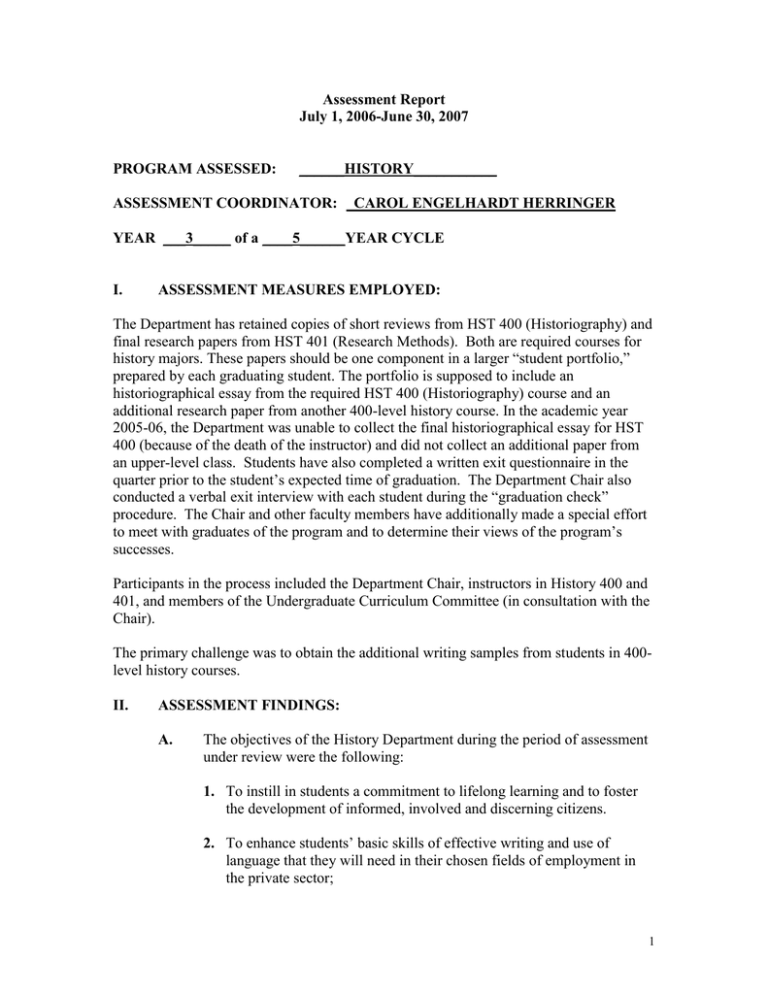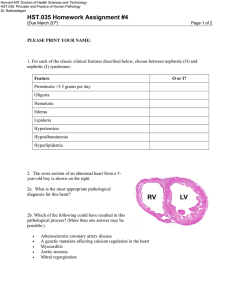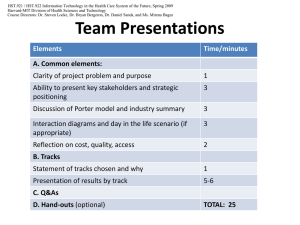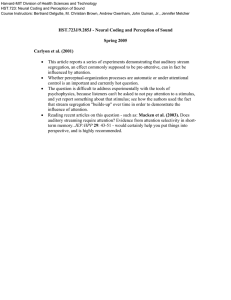Assessment Report July 1, 2006-June 30, 2007
advertisement

Assessment Report July 1, 2006-June 30, 2007 PROGRAM ASSESSED: ______HISTORY___________ ASSESSMENT COORDINATOR: _CAROL ENGELHARDT HERRINGER YEAR ___3_____ of a ____5______YEAR CYCLE I. ASSESSMENT MEASURES EMPLOYED: The Department has retained copies of short reviews from HST 400 (Historiography) and final research papers from HST 401 (Research Methods). Both are required courses for history majors. These papers should be one component in a larger “student portfolio,” prepared by each graduating student. The portfolio is supposed to include an historiographical essay from the required HST 400 (Historiography) course and an additional research paper from another 400-level history course. In the academic year 2005-06, the Department was unable to collect the final historiographical essay for HST 400 (because of the death of the instructor) and did not collect an additional paper from an upper-level class. Students have also completed a written exit questionnaire in the quarter prior to the student’s expected time of graduation. The Department Chair also conducted a verbal exit interview with each student during the “graduation check” procedure. The Chair and other faculty members have additionally made a special effort to meet with graduates of the program and to determine their views of the program’s successes. Participants in the process included the Department Chair, instructors in History 400 and 401, and members of the Undergraduate Curriculum Committee (in consultation with the Chair). The primary challenge was to obtain the additional writing samples from students in 400level history courses. II. ASSESSMENT FINDINGS: A. The objectives of the History Department during the period of assessment under review were the following: 1. To instill in students a commitment to lifelong learning and to foster the development of informed, involved and discerning citizens. 2. To enhance students’ basic skills of effective writing and use of language that they will need in their chosen fields of employment in the private sector; 1 3. To prepare students for professional schools, i.e., law school. 4. To prepare students for entry into graduate and professional programs such as law school and graduate programs in history. 5. To prepare students for employment in the public sector such as governmental agencies including the State Department and the Department of Education as well as public history organizations including historic sites, museums, historical societies and archives. B. Objectives Findings: 1. Of the six (6) students who completed an exit interview, four (4) indicated that they planned to pursue a master’s degree. One (1) plans to pursue a Master’s in Education at WSU, one (1) plans to pursue a Master’s degree in an unspecified field at WSU, one (1) plans to pursue a Master’s degree in Library Science at Kent State University, and one (1) plans to pursue a Master’s degree in public history or a related field without specifying an institution. See A2, A3, A5 2. Of the six (6) students who completed an exit interview, two (2) strongly agreed that their education in the History Department influenced their professional lives, three (3) agreed, and only one (1) disagreed. See A1, A2, A3, A4, A5 3. The students who completed the exit interview were very positive about the variety of courses offered by the history department (8.0 on a 10-point scale), the attention faculty give to individual students’ work (8.8), the quality of departmental advising (7.0), and the course requirements (7.8). They were also very positive (9.5) about the atmosphere and helpfulness of the department office. They were less positive (6.5) about the scheduling of classes. 4. A review of graduate school admissions indicated that one (1) student was admitted to the graduate program as a non-degree student at WSU and one (1) was admitted to the M.A. program in history at WSU. All students, however, have not informed the department of their admission to graduate and professional schools. See A3, A4, A5 5. A full analysis of graduate school and professional school admissions and of the students’ success in graduate and professional schools must await the findings of the alumni survey that is planned for the fifth year of the review cycle. See A2, A3, A4, A5 2 C. The learning outcomes of the History Department during the period of assessment under review were the following: 1. Graduates will display writing proficiency. 2. Graduates will display knowledge of the methodology that historians use. 3. Graduates will display the ability to critically analyze primary and secondary materials and to arrive at coherent and well organized conclusions. 4. Graduates will display an awareness and appreciation of most of the following: the diversity of cultures, ideologies, and/or economic, political, social and religious systems at different points in time and place. D. Learning Outcomes Findings: 1. During the 2005-2006 academic year, twenty-two (22) students completed HST 401 (Research Methods) in the Fall 2006 and Spring 2007 quarters. In addition, eleven (11) students completed HST 400 in Fall 2006 quarter. Assessment of learning outcomes was based on students’ performance on the capstone assignment for the Research Methods course - a major research paper that requires each student to investigate a historical topic, using both primary and secondary sources - and on short analytical papers from HST 401. The members of the department’s Undergraduate Curriculum Committee read the individual papers, rating them according to the following set of measurable benchmarks: a. The student’s work demonstrates a command of the methodology employed by historians. b. The student’s work demonstrates writing proficiency. c. The student’s written work demonstrates a grasp of subject matter, historiography, and interpretation. d. The student’s written work demonstrates the analytical, organizational, and critical skills desired. Undergraduate Curriculum Committee members gave a rating of “M” (“meets”), “N” (“does not meet”), or “E” (“exceeds”) for each of the four benchmarks for each HST 401 paper and for each student in HST 400. 2. The Committee’s consensual findings on the papers by benchmark were as follows: 3 a. “The student’s work demonstrates a command of the methodology employed by historians.” Eighteen (18) students met the standard (M); six (6) students exceeded the standard (E); nine (9) students failed to meet the standard (N). b. “The student’s work demonstrates writing proficiency.” Nineteen (19) students met the standard (M); six (6) students exceeded the standard (E); eight (8) students failed to meet the standard (N). c. “The student’s written work demonstrates a grasp of subject matter, historiography, and interpretation.” Sixteen (16) students met the standard (M); seven (7) students exceeded the standard (E); nine (9) students failed to meet the standard (N). d. “The student’s written work demonstrates the analytical, organizational, and critical skills desired.” Thirteen (13) students met the standard (M); eight (8) students exceeded the standard (E); twelve (12) students failed to meet the standard (N). See A2, C1, C2, C3 3. Of the five (5) students who completed an exit interview, two (2) strongly agreed that their experiences in the History Department influenced their personal lives and three (3) agreed. See A1 4. An overall analysis of the assessment measures indicated that the History Department had a more difficult time achieving its learning outcomes in the academic year under review. This may be due in part to having a second-year faculty member teach HST 401; another problem was the absence of final papers for HST 400 for review. See C1, C2, C3 5. Objective 4 is not measurable through the papers submitted, but is achieved through the course distribution required of all history majors. History majors are required to take 8 hours of upper-level courses in each of the following fields: U.S., European, and non-western history. In addition, they must take 16 additional hours of upper-level coursework in classes of their choosing. III. PROGRAM IMPROVEMENTS: In order to ensure that learning outcomes are met for the next assessment period, the chair of the Undergraduate Curriculum Committee will ensure that all faculty teaching HST 400 and 401 are aware of the learning outcomes. In addition, to address the fact that portfolios have not been completed, the History Department has instituted a procedure in which the administrative specialist who schedules exit interviews with the chair of the department will at the same time request that students bring a paper from a 400-level history class to put in the portfolio. The support staff will also ensure that every graduating student completes an exit interview. 4 IV. ASSESSMENT PLAN COMPLIANCE: No significant deviation from the History Department’s Program Assessment Plan aside from the need to complete the portfolio and the exit interview. V. NEW ASSESSMENT DEVELOPMENTS: In the future, honors theses (HST 402) will also be evaluated as part of the assessment process. 5



